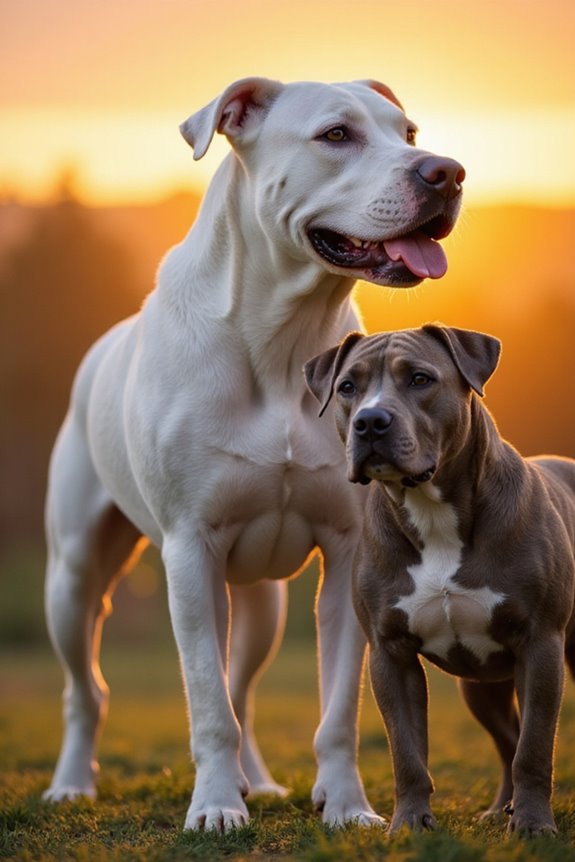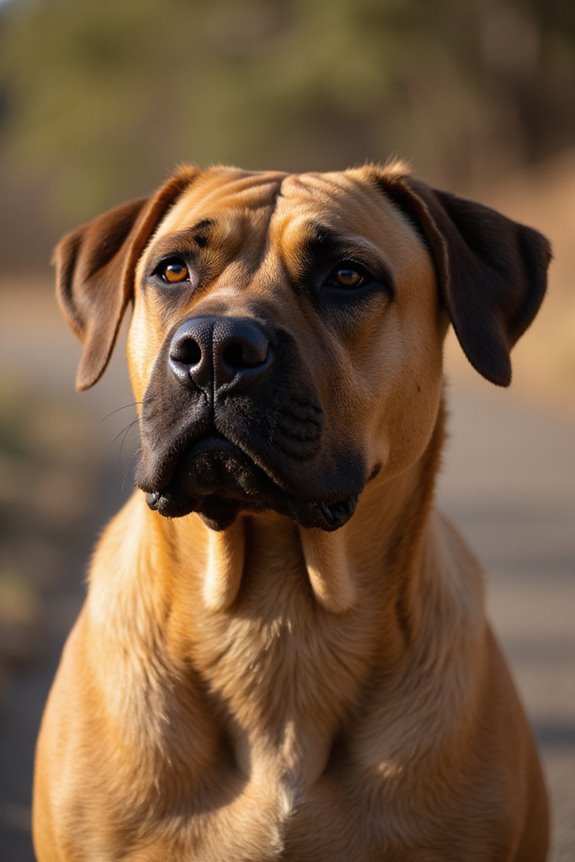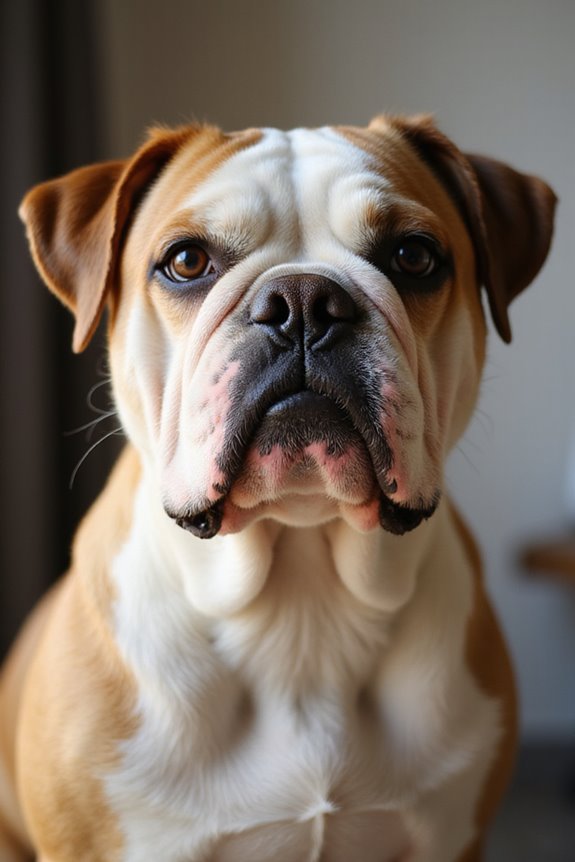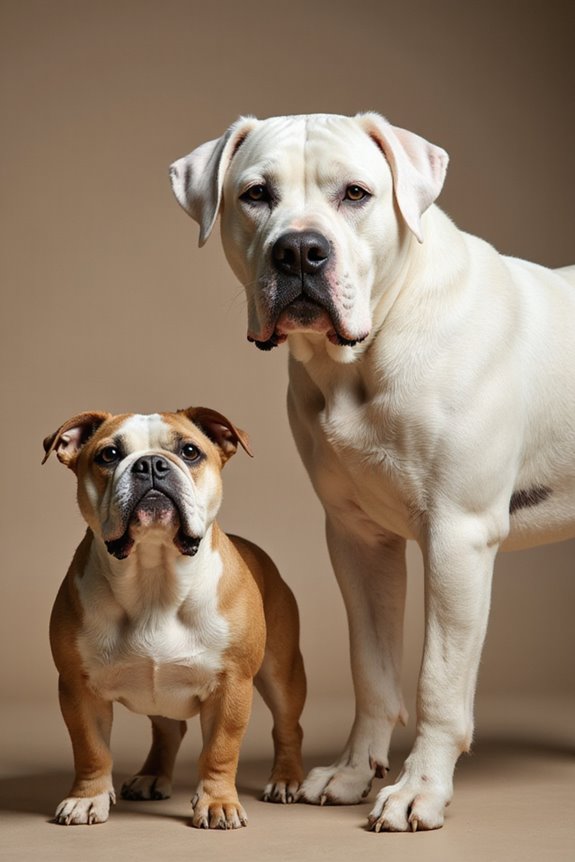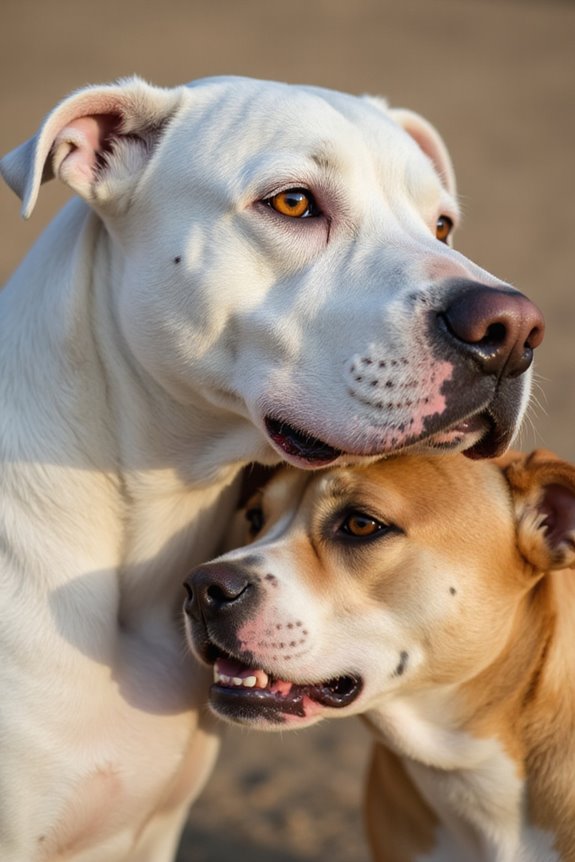The Dogo Argentino, originating from Argentina, was developed in the 1920s for big-game hunting, whereas the Spanish Alano‘s lineage dates back centuries in Spain for various working roles. Physical traits differ; Dogo Argentinos are larger and have white coats, while Spanish Alanos are smaller with coat colors like brindle and black. Temperament also varies; Dogo Argentinos are affectionate, necessitating socialization, while Spanish Alanos show dominant tendencies requiring consistent training. Proceed to explore additional insights regarding their exercise needs and health considerations.
Key Takeaways
- The Dogo Argentino hails from Argentina, developed for big-game hunting, while the Spanish Alano has roots in Spain dating back centuries.
- Dogo Argentino is larger, weighing 80-105 pounds, while Spanish Alano typically weighs 60-90 pounds, reflecting their different purposes.
- Both breeds require firm leadership, but the Dogo Argentino enjoys involvement, whereas the Spanish Alano prefers a structured environment.
- Dogo Argentinos generally require 60 to 90 minutes of vigorous exercise daily, while Spanish Alanos need about 45 to 60 minutes.
- Lifespan differs slightly: Dogo Argentinos live 9-15 years, while Spanish Alanos typically range from 10-14 years.
Origin and History
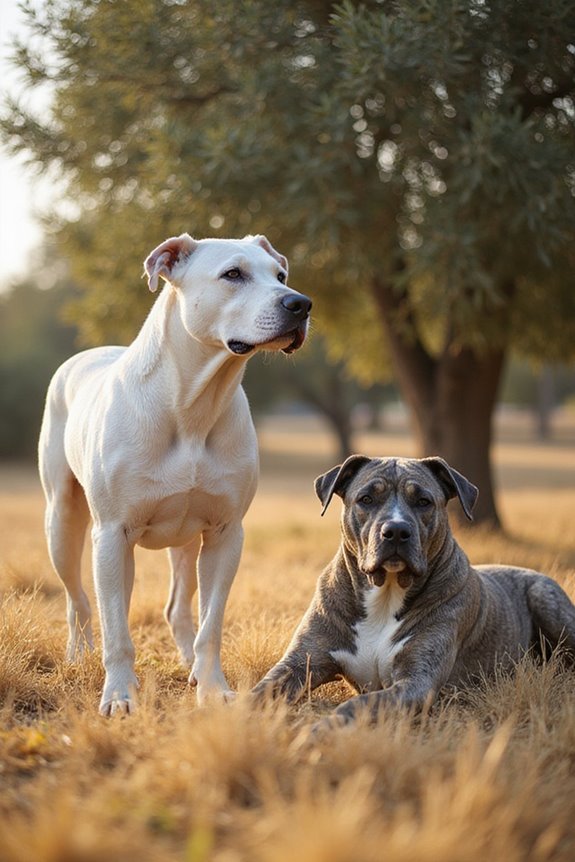
The origins and histories of the Dogo Argentino and the Spanish Alano reflect distinct geographical, cultural, and functional developments within the canine lineage.
- Dogo Argentino: Developed in the 1920s in Argentina by Dr. Antonio Nores Martinez, its primary purpose was big-game hunting. This breed was meticulously crafted for strength, with a focus on breed preservation through selective crossbreeding. The cultural significance of this breed extends to its recognition as Argentina’s first official breed by the FCI in 1973.
- Spanish Alano: With a lineage tracing back centuries, this breed served multifunctional roles in warfare and livestock management. The cultural relevance of the Spanish Alano lies in its adaptability and historical ties to Spanish heritage, embodying both legacy and tradition as a working dog.
Physical Characteristics
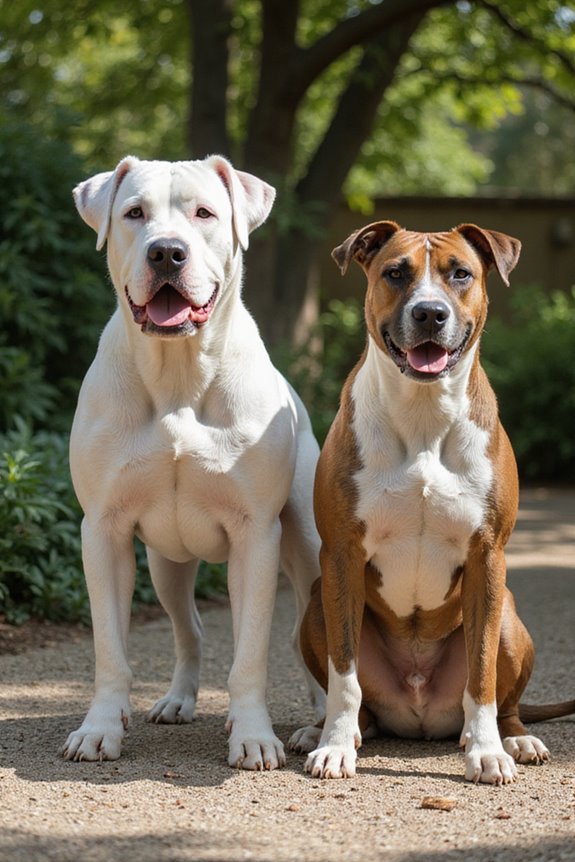
When comparing the physical characteristics of the Dogo Argentino and the Spanish Alano, it becomes evident that each breed displays unique traits shaped by their distinct purposes and environments.
- Size Comparison: The Dogo Argentino is a large breed, with males standing 24 to 27 inches tall and weighing between 80 to 105 pounds. In contrast, the Spanish Alano ranges from 22 to 26 inches and weighs 60 to 90 pounds, making it noticeably lighter.
- Coat Differences: The Dogo Argentino sports a short, smooth, and white coat, while the Spanish Alano’s coat is short and dense, available in black, brindle, or fawn. These adaptations reflect their respective hunting origins and regional climates, enhancing their functionality in different environments.
Temperament and Behavior
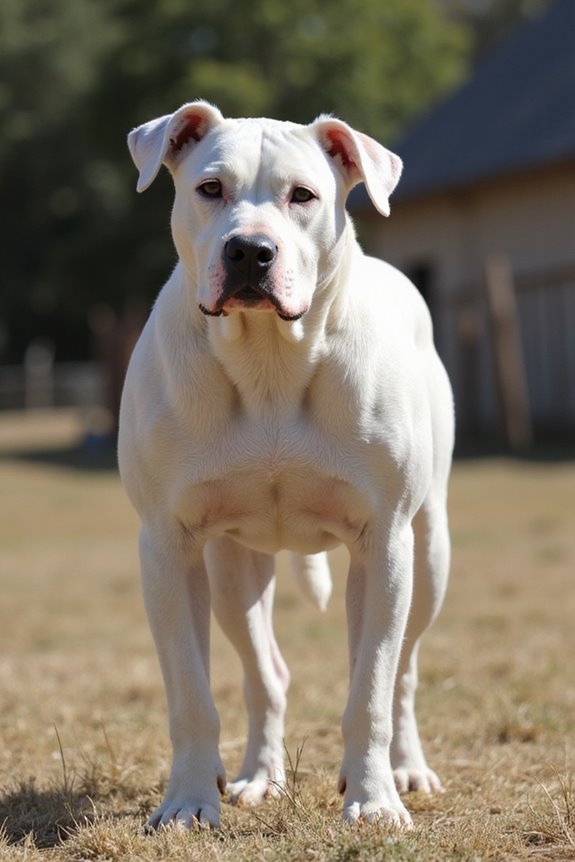
Understanding the temperament and behavior of both the Dogo Argentino and the Spanish Alano is essential for potential owners, especially as these breeds exhibit distinct characteristics that can markedly affect their suitability for various lifestyles.
- Behavioral Differences: The Dogo Argentino is generally more affectionate, enthusiastic to please, and requires early socialization to thrive. In contrast, the Spanish Alano, while loving, displays a stronger will and dominant tendencies, necessitating consistent training.
- Social Dynamics: The Spanish Alano tends to be more family-friendly, particularly with children. Still, both breeds need firm leadership and careful handling due to their unique traits. While the Dogo Argentino enjoys being involved, the Alano Espanol prefers a structured environment to function harmoniously within a family setting.
Energy Levels and Exercise Needs
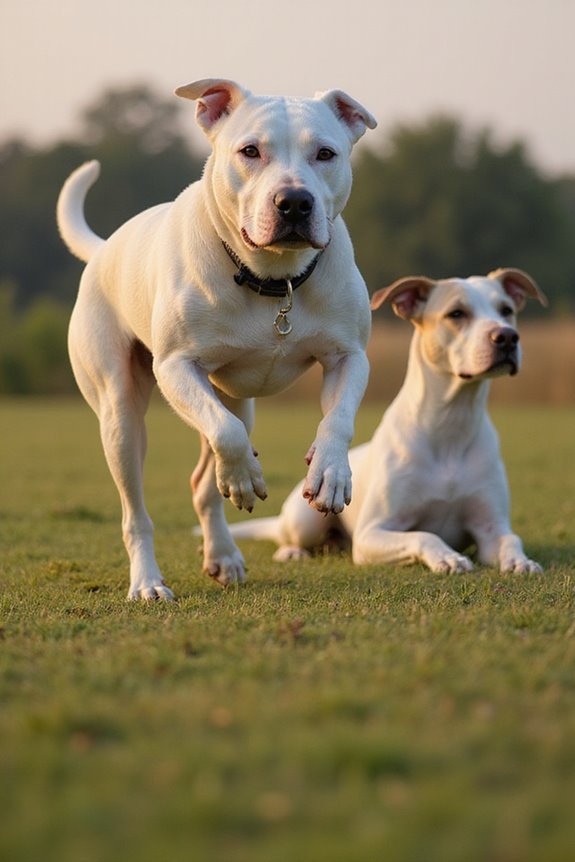
Both the Dogo Argentino and Spanish Alano exhibit distinct energy levels and exercise needs that potential owners must consider when selecting a breed.
- Dogo Argentino:
- High energy, requiring 60 to 90 minutes of vigorous exercise daily.
- Activities include running, fetch, and brisk walks to handle exercise intensity.
- Needs ample space and isn’t suitable for apartment living.
- Spanish Alano:
- Moderate to high energy, needing 45 to 60 minutes of daily exercise.
- Engages well with interactive play, obedience training, and agility tasks.
- Adaptable to various environments; regular activity guarantees energy management.
Both breeds require mental stimulation alongside physical activities to maintain well-being and prevent behavioral issues related to insufficient exercise.
Bite Force and Protection
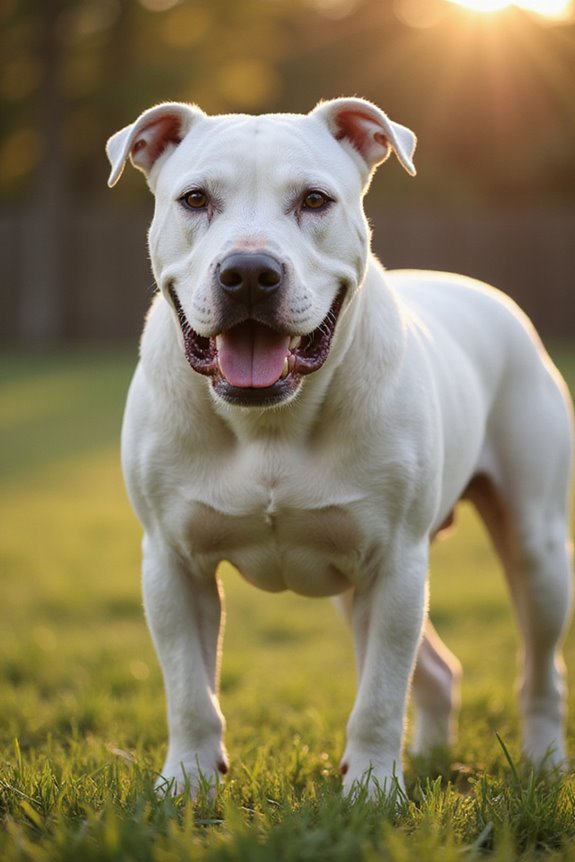
Moving from the consideration of energy levels and exercise needs, it’s important to address another crucial factor when comparing the Dogo Argentino and the Spanish Alano: their bite force and protection capabilities.
- Bite Strength Comparison: The Dogo Argentino boasts an impressive bite force of approximately 500 PSI, ranking it among the strongest breeds. In contrast, the Spanish Alano has a more modest bite force of around 227 PSI.
- Guarding Instincts: Both breeds are protective, but their instincts manifest differently. The Dogo Argentino requires training for effective guard duties and is more welcoming toward families. The Spanish Alano, while also a formidable guardian, necessitates assertive leadership to direct its protective nature appropriately.
Proper training and socialization for both breeds will greatly enhance their guarding effectiveness while mitigating risks.
Lifespan and Health
When considering the lifespan and health of the Dogo Argentino and the Spanish Alano, it’s essential to recognize the various factors that influence their longevity.
- Lifespan Comparison: The Dogo Argentino typically lives between 9 to 15 years, while the Spanish Alano usually ranges from 10 to 14 years, aligning with their medium to large breed status.
- Health Challenges: Dogo Argentinos can face serious issues, including hip dysplasia and congenital deafness, affecting their quality of life. They may also develop eye conditions like glaucoma. Meanwhile, Spanish Alanos may experience similar orthopedic concerns but lack specific breed health documentation.
Regular veterinary check-ups, alongside proper nutrition and exercise, are important to mitigate these challenges and enhance both breeds’ overall health and lifespan.
Training and Socialization Requirements
Effective training and socialization are essential for the Dogo Argentino and Spanish Alano, as both breeds exhibit distinct characteristics that can influence their behavior.
- Early Socialization: Both breeds thrive with early exposure to various environments, people, and animals. This foundation prevents aggression and helps them adapt to diverse situations.
- Training Methods: Dogo Argentinos respond best to positive reinforcement, while Spanish Alanos require a balanced approach of firmness and encouragement.
- Session Length: Short, focused training sessions work best, ensuring they stay engaged and avoid frustration.
- Exercise: Ample exercise is critical, integrating physical activity with training enhances concentration.
This commitment to socialization techniques and well-structured training methods will greatly improve their behavior and relationship with you.
Choosing the Right Breed for Your Lifestyle
Choosing the right breed for your lifestyle is vital to guaranteeing a harmonious relationship between you and your canine companion. When considering breed compatibility, think about your living space, activity level, and family dynamics.
- Living Space: Both the Dogo Argentino and Spanish Alano need medium to large yards, making them unsuitable for apartment living.
- Activity Needs: The Dogo Argentino demands more vigorous exercise compared to the moderately active Spanish Alano.
- Temperament: If you have children or other pets, the Spanish Alano is generally more tolerant and affectionate.
It’s important to align your owner lifestyle with the dog’s requirements. Assess potential health concerns and confirm you can dedicate time for training and socialization. Understanding these elements will help you make an informed decision.
Frequently Asked Questions
What Are the Grooming Needs of Dogo Argentino and Spanish Alano?
When it comes to grooming needs, both breeds enjoy a bit of pampering. I brush my Dogo once weekly and give the Spanish Alano regular gentle care, ensuring their coats remain healthy and vibrant.
How Do the Breeds Interact With Other Animals?
When I think about how these breeds interact with pets, proper socialization techniques are essential. I’ve found early exposure and consistent training foster harmony, allowing them to thrive alongside other animals in a loving home environment.
What Are Common Behavioral Problems in Each Breed?
I’ve noticed both breeds face common challenges, like aggression issues and training troubles. They need early socialization and consistent training to thrive. Understanding their unique quirks can help tailor a loving, effective approach for happier pets.
Are These Breeds Hypoallergenic?
If you’re wondering about hypoallergenic traits, neither breed really fits the bill. As an allergy sufferer myself, I know both can trigger reactions, so regular grooming might help, but it won’t fully prevent allergies.
How Do Climate Conditions Affect Their Health?
You know, climate adaptation shapes our dogs’ lives profoundly. In extreme conditions, health challenges arise; from heat stress to joint pain. We must nurture them, ensuring comfort to help them thrive in any climate they encounter.

